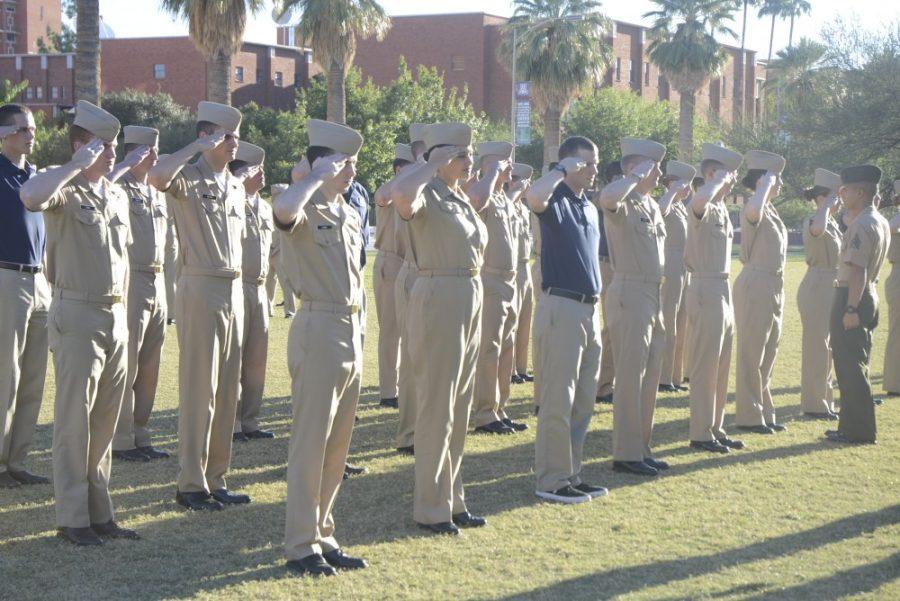A trio of instructors with more than 75 years of combined military service are working to bring continuity and expertise to the UA’s Reserve Officers’ Training Corps.
Instructors at the UA’s Reserve Officers’ Training Corps seek to train students to become commissioned officers in the Air Force, Army, Navy and Marine Corps.
Students are offered scholarship contracts that require them to perform a term of obligatory service upon graduation from the ROTC program. The terms can last from four to 10 years based on the branch of the military and conditions of the contract. Army ROTC graduates may be commissioned for active or reserve duty, while Air Force and Navy graduates incur a mandatory term of active duty.
Colonel Mike Kuhn
Colonel Mike Kuhn of the United States Marine Corps is a professor of naval science who began working with the UA ROTC this summer.
Kuhn, who said he was always impressed by the Marines, began his military career as a Naval ROTC midshipman in 1984, and was commissioned as a second lieutenant four years later. During his time on active duty, Kuhn was trained and deployed in more than 30 countries, including Iraq, Japan and Korea.
Kuhn, who specialized in amphibious armored vehicles, was at one point in charge of about 230 vehicles and 1,200 marines as a battalion commander.
He said his favorite job, though, is his current position instructing the young men and women of the UA ROTC.
“It’s a lot of fun,” he said. “[The cadets and midshipmen] are choosing to serve the country over themselves, which is pretty impressive. It’s fun working with that kind of person.”
Colonel Brian Donahoo
As he grew up a Navy brat, Colonel Brian Donahoo’s involvement with the military dates back to an early age.
After joining the Air Force as an enlisted member, he went to work fixing C-130’s at a base in North Carolina. He then left the military for two years to earn his degrees in math and computer science before returning to the Air Force and training as a pilot.
Donahoo has flown B-1 bombers off and on since 1990, during which time he also held an administrative position at the Pentagon.
His most significant deployment, however, was on the ground. In 2009, he was stationed in an embassy in Baghdad, where he served as chief of staff for the Force Strategic Engagement Cell, an outfit designed to reconcile differences between warring factions in Iraq.
In his current role as a professor of aerospace studies with the ROTC, Donahoo said he thoroughly enjoys helping develop the “leaders of tomorrow.”
“This is really about what’s good for our country,” he said, adding that while people join the military for a variety of reasons, those who stay in the military “do so out of that sense of service, and because they really enjoy what they’re doing.”
Lieutenant Colonel Benjamin J. Walters
Fueled by a desire to travel the world while serving his country, Lieutenant Colonel Benjamin J. Walters, professor and head of the Department of Military Science, Tactics, and Leadership, enlisted in the Army at the age of 17.
“The Army offered to send me to Europe so I was like, ‘Sign me up. I’m ready to go,’” he said.
He served as a field artillery soldier for five years, then decided to pursue a career as an officer through the Army’s Green to Gold program.
After receiving his bachelor’s degree in political science, Walters was commissioned as a logistics officer, meaning he dealt with the procurement and transportation of supplies for the military.
During his 17 years as an officer, he was deployed to countries including Saudi Arabia, Kosovo, Germany, Iraq and Afghanistan.
Watching the cadets grow both personally and as soldiers is the most rewarding part of Walters’ job, he said.
“Holistically, there is a reason why we have a military, and that’s to protect our freedoms and our way of life,” he said, “so we need quality people to man our Army, our Air Force, our Navy, our Marine Corps.”
One student under the instruction of Walters is Cadet Major Charles Dearmore, a history senior who will join the Arizona National Guard after he graduates. He credits the strength of the UA ROTC to its very experienced instructors.
“The instructors have a huge wealth of knowledge,” he said. “They’re always willing to take a minute and give you advice if you need it. It’s great.”
Although the experience has been mentally and physically demanding, Dearmore said that he’s grateful for the discipline, skills and the friends he has acquired during his time in training. Some instructors said it is this motivation that qualifies as the best part of the job.
“It’s really great to see that transformation in these young people,” Walters said. “They’re so ready to get out there and [get commissioned] because they’ve spent the last three or four years training for this event … They know they’re ready, and that’s the most amazing aspect of this job.”
By the numbers
Cadets/Midshipmen at the UA:
Army: 131
Air Force: 130
Navy/USMC: 102
Women
Army: 31 percent
Air Force: percent*
Navy/USMC: percent
*approximate value
– Follow Mark Armao @MarkGnarly









